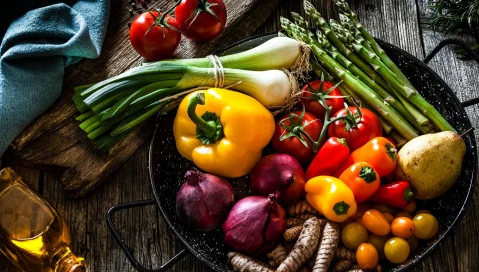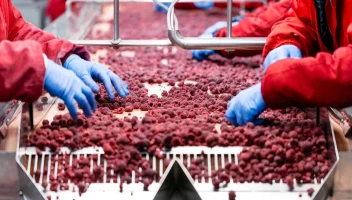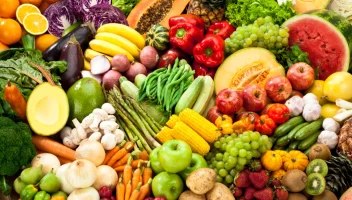Aptean’s Food and Beverage 2021 Global Symposium – The Fresh Produce Future Session Recap
Aptean’s Food and Beverage 2021 Global Symposium – The Fresh Produce Future Session Recap
Aptean’s Food and Beverage 2021 Global Symposium – The Fresh Produce Future Session Recap
26 Okt 2021
John McCurdy
For this next entry in our continuing series recapping the sessions from Aptean’s Food and Beverage 2021 Global Symposium, we’ve gathered the key takeaways from the breakout session entitled “The Fresh Produce Future: Data-Driven Insights, Sustainability and More,” presented by Anouk Sijmonsma, vice president of global membership engagement for the Produce Marketing Association (PMA).
Sijmonsma helps lead PMA as a trade organization serving all sectors of the produce and floral industries. Their vision of bringing together these global communities to grow a healthier world involves creating connections between members, providing critical information and promoting industry solutions that help businesses tackle difficult challenges.
Their five areas of specialization—science and technology, sustainability, global connectivity, talent development and demand generation—each represent possibilities for expansion for fresh produce and floral organizations. The Association’s 2021 Environmental Scan, a report created by engaging with members and subject matter experts both internal and external to paint a complete picture of the present circumstances, revealed three underlying forces prompting change in the industry.
Three Key Forces Driving Change
The report found that shifts in global trade patterns; demographic, cultural and social factors; and consumer motivations, preferences and expectations are the main drivers behind the evolution of the global fresh produce marketplace. These factors, alongside an increased emphasis on sustainability and advancements in science and technology, are changing how companies operate and will continue to do so in the coming years.
Global Trade
While the United States and China remain the preeminent economic powers, the COVID-19 pandemic has shaken up global trade patterns in significant ways. Total trade value continues to increase—it grew from 40% of the world’s GDP in 1980 to 60% in the first quarter of 2020—the impending economic downturn will likely hit exporters like Mexico hardest.
Meanwhile, China, India and Indonesia are on track to rank as the largest 3 economies in the world by 2050, and Indonesia, Thailand and Malaysia are on pace to account for 2/3 of all manufactured goods consumption by 2025. Africa is also home to emerging markets, with 40% of the population considered middle- or upper-class and combined spending across the continent to reach $2.5 trillion by 2030.
Demographic, Cultural and Social Factors
“Slowbalization” has entered the public consciousness to describe the exposed failures of existing international supply chains. The flow of goods was delayed or even stopped entirely at various points in the pandemic era, as the ties between nations and even regions within individual countries have weakened and local sourcing has become a greater priority.
Populations in some areas are even undergoing de-urbanization, which could have harmful effects on both the environment and economic growth. The greater distances that products must travel to consumers requires more energy expenditure, and the innovation that cities foster as cultural centers could slow as people move further apart.
Consumer Motivations, Preferences and Expectations
Shutdowns around the globe and prolonged periods of uncertainty prompted consumers to focus on regaining control where it could be seized, and many shifted to more mindful use of the vital resources of time, money and energy. This “homebody economy” has created demand for more value in products, a focus on household necessities and more emphasis on brand trust and loyalty.
Cooking at home and delivery services have also skyrocketed in popularity during the pandemic, which is informing new sales models for fresh produce businesses. However, many consumers are reaching a point of burnout due to the inundation of marketing information delivered through their connected devices and smartphones.
The Industry’s Response
Fresh produce businesses were already gravitating toward even greater incorporation of technology in their operations, but the above change drivers are accelerating the process. From artificial intelligence and machine learning to factory automation, increased adoption can be expected over the next several years.
The industry has also reacted to the surge in popularity of online and mobile ordering, including the launch of new models like in-store pickup and direct-to-consumer sales. The online grocery market, which was valued at $190 billion in 2019, is forecast to balloon to $1.1 trillion by 2027, demonstrating the need to optimize these new outlets.
Fewer, shorter trips to the store on the part of consumers will also stress the need for packaging that optimizes shelf life while still being environmentally friendly. That said, if sustainability concerns are crucial, food safety considerations are even more important.
The U.S. Food and Drug Administration’s “New Era of Smarter Food Safety” aims to increase the use of intelligent traceability tools and predictive analytics to allow food and beverage businesses to react to outbreaks more quickly. This will no doubt have major implications for the fresh produce sector, which already faces tight timetables due to the nature of the products.
Eyes to the Future
The fresh produce industry is in a critical period of transition as we embrace a “new normal” around the world.
“The future of the produce industry is rooted in the choices we make now,” Sijmonsma said. “Collaboration throughout the supply chain is crucial in today’s environment, where the pace of change and adaptation of disruptive technologies is faster than ever.”
It’s clear from the findings of PMA’s 2021 Environmental Scan that technology will be central to the continuing evolution of food and beverage markets. At Aptean, we have the enterprise resource planning (ERP) solutions that forward-thinking businesses need to align their traceability, food safety, operational efficiency and sustainability efforts.
Our systems also offer powerful analytical tools that yield actionable insights. Organizations will need such data-driven guidance to make the right changes in a future where “the biggest trap may be not challenging status-quo thinking,” as Sijmonsma put it.
For more information on Aptean Food & Beverage ERP and our other purpose-built platforms, contact us today.
Be sure to also check back for more of our session recaps, and browse our Insights page for those we’ve published previously. And if you’d like to view any of our sessions on-demand, you can do so here.
Related Content


Wilt u weten wat we voor uw voedingsbedrijf kunnen betekenen?
Wij helpen u graag. Neem contact met ons op en ontdek welke smaken we te bieden hebben.






